Boyong Wu
Step-Audio 2 Technical Report
Jul 24, 2025Abstract:This paper presents Step-Audio 2, an end-to-end multi-modal large language model designed for industry-strength audio understanding and speech conversation. By integrating a latent audio encoder and reasoning-centric reinforcement learning (RL), Step-Audio 2 achieves promising performance in automatic speech recognition (ASR) and audio understanding. To facilitate genuine end-to-end speech conversation, Step-Audio 2 incorporates the generation of discrete audio tokens into language modeling, significantly enhancing its responsiveness to paralinguistic information such as speaking styles and emotions. To effectively leverage the rich textual and acoustic knowledge in real-world data, Step-Audio 2 integrates retrieval-augmented generation (RAG) and is able to call external tools such as web search to mitigate hallucination and audio search to switch timbres. Trained on millions of hours of speech and audio data, Step-Audio 2 delivers intelligence and expressiveness across diverse conversational scenarios. Evaluation results demonstrate that Step-Audio 2 achieves state-of-the-art performance on various audio understanding and conversational benchmarks compared to other open-source and commercial solutions. Please visit https://github.com/stepfun-ai/Step-Audio2 for more information.
Step-Audio-AQAA: a Fully End-to-End Expressive Large Audio Language Model
Jun 10, 2025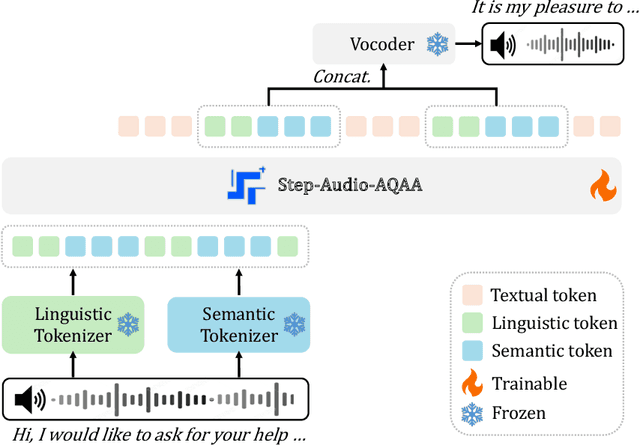
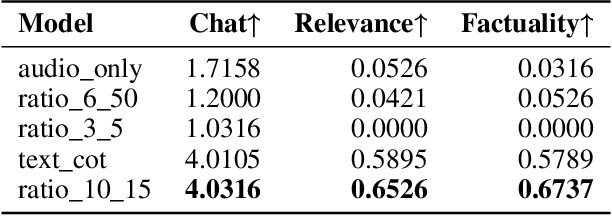
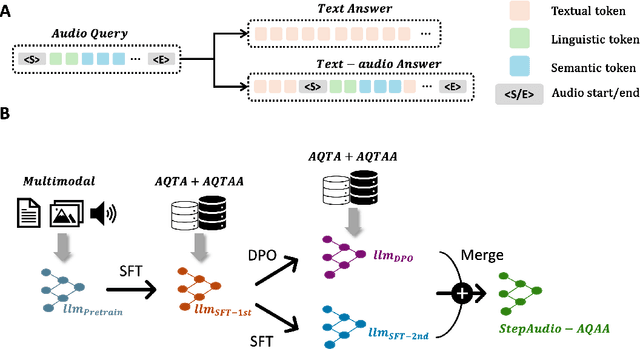

Abstract:Large Audio-Language Models (LALMs) have significantly advanced intelligent human-computer interaction, yet their reliance on text-based outputs limits their ability to generate natural speech responses directly, hindering seamless audio interactions. To address this, we introduce Step-Audio-AQAA, a fully end-to-end LALM designed for Audio Query-Audio Answer (AQAA) tasks. The model integrates a dual-codebook audio tokenizer for linguistic and semantic feature extraction, a 130-billion-parameter backbone LLM and a neural vocoder for high-fidelity speech synthesis. Our post-training approach employs interleaved token-output of text and audio to enhance semantic coherence and combines Direct Preference Optimization (DPO) with model merge to improve performance. Evaluations on the StepEval-Audio-360 benchmark demonstrate that Step-Audio-AQAA excels especially in speech control, outperforming the state-of-art LALMs in key areas. This work contributes a promising solution for end-to-end LALMs and highlights the critical role of token-based vocoder in enhancing overall performance for AQAA tasks.
Step-Audio: Unified Understanding and Generation in Intelligent Speech Interaction
Feb 18, 2025Abstract:Real-time speech interaction, serving as a fundamental interface for human-machine collaboration, holds immense potential. However, current open-source models face limitations such as high costs in voice data collection, weakness in dynamic control, and limited intelligence. To address these challenges, this paper introduces Step-Audio, the first production-ready open-source solution. Key contributions include: 1) a 130B-parameter unified speech-text multi-modal model that achieves unified understanding and generation, with the Step-Audio-Chat version open-sourced; 2) a generative speech data engine that establishes an affordable voice cloning framework and produces the open-sourced lightweight Step-Audio-TTS-3B model through distillation; 3) an instruction-driven fine control system enabling dynamic adjustments across dialects, emotions, singing, and RAP; 4) an enhanced cognitive architecture augmented with tool calling and role-playing abilities to manage complex tasks effectively. Based on our new StepEval-Audio-360 evaluation benchmark, Step-Audio achieves state-of-the-art performance in human evaluations, especially in terms of instruction following. On open-source benchmarks like LLaMA Question, shows 9.3% average performance improvement, demonstrating our commitment to advancing the development of open-source multi-modal language technologies. Our code and models are available at https://github.com/stepfun-ai/Step-Audio.
Transferable speech-to-text large language model alignment module
Jun 19, 2024
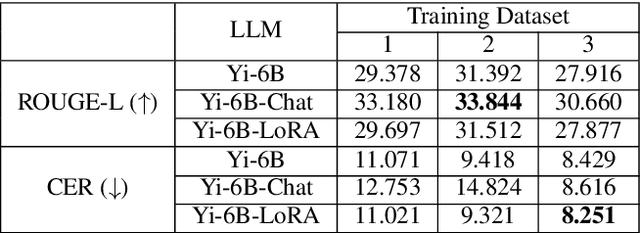


Abstract:By leveraging the power of Large Language Models(LLMs) and speech foundation models, state of the art speech-text bimodal works can achieve challenging tasks like spoken translation(ST) and question answering(SQA) altogether with much simpler architectures. In this paper, we utilize the capability of Whisper encoder and pre-trained Yi-6B. Empirical results reveal that modal alignment can be achieved with one layer module and hundred hours of speech-text multitask corpus. We further swap the Yi-6B with human preferences aligned version of Yi-6B-Chat during inference, and discover that the alignment capability is applicable as well. In addition, the alignment subspace revealed by singular value decomposition(SVD) also implies linear alignment subspace is sparse, which leaves the possibility to concatenate other features like voice-print or video to expand modality.
Hard Sample Mining for the Improved Retraining of Automatic Speech Recognition
Apr 17, 2019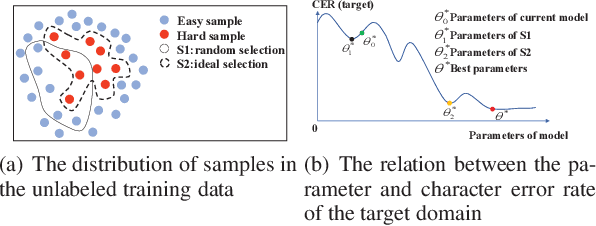

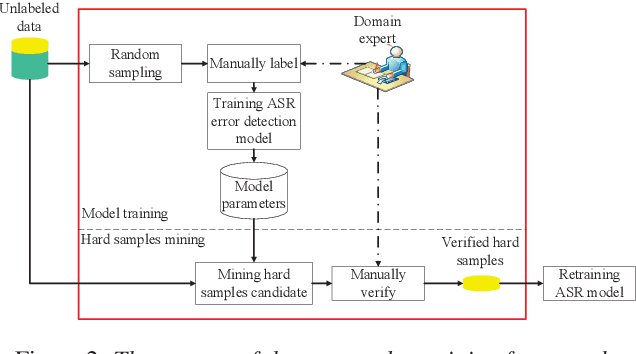

Abstract:It is an effective way that improves the performance of the existing Automatic Speech Recognition (ASR) systems by retraining with more and more new training data in the target domain. Recently, Deep Neural Network (DNN) has become a successful model in the ASR field. In the training process of the DNN based methods, a back propagation of error between the transcription and the corresponding annotated text is used to update and optimize the parameters. Thus, the parameters are more influenced by the training samples with a big propagation error than the samples with a small one. In this paper, we define the samples with significant error as the hard samples and try to improve the performance of the ASR system by adding many of them. Unfortunately, the hard samples are sparse in the training data of the target domain, and manually label them is expensive. Therefore, we propose a hard samples mining method based on an enhanced deep multiple instance learning, which can find the hard samples from unlabeled training data by using a small subset of the dataset with manual labeling in the target domain. We applied our method to an End2End ASR task and obtained the best performance.
 Add to Chrome
Add to Chrome Add to Firefox
Add to Firefox Add to Edge
Add to Edge